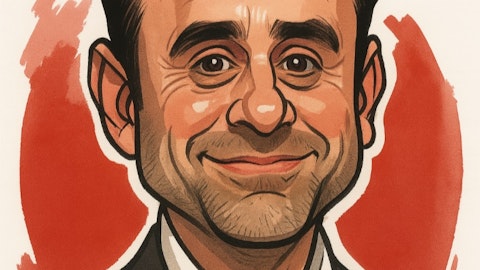Southside Bancshares, Inc. (NASDAQ:SBSI) Q2 2025 Earnings Call Transcript July 25, 2025
Southside Bancshares, Inc. beats earnings expectations. Reported EPS is $0.72, expectations were $0.69.
Operator: Thank you for standing by, and welcome to Southside Bancshares’ Second Quarter 2025 Earnings Conference Call. [Operator Instructions] I would now like to hand the call over to Lindsey Bailes, Vice President, Investor Relations. Please go ahead.
Lindsey Bailes: Thank you, Latif. Good morning, everyone, and welcome to Southside Bancshares’ Second Quarter 2025 Earnings Call. A transcript of today’s call will be posted on southside.com under Investor Relations. During today’s call and in other disclosures and presentations, I remind you forward-looking statements are subject to risks and uncertainties. Factors that could materially change our current forward-looking assumptions are described in our earnings release and our Form 10-K. Joining me today are CEO, Lee Gibson; President, Keith Donahoe; and CFO, Julie Shamburger. First, Lee will start us off with his comments on the quarter, then Keith will discuss loans and credit, and then Julie will give an overview of our financial results. I will now turn the call over to Lee.
Lee R. Gibson: Thank you, Lindsey, and welcome to today’s call. We had an excellent quarter with net income of $21.8 million, resulting in diluted earnings per share of $0.72, an annualized return on average assets of 1.07% and an annualized return on average tangible common equity of 14.38%. I want to thank our dedicated team members for their hard work and contributions that were instrumental in producing these results. Linked quarter, our net interest margin increased 9 basis points to 2.95% and net interest income increased $414,000 to $54.3 million. The yield on our earning assets increased 2 basis points and the cost of our interest-bearing liabilities decreased by 5 basis points. Linked quarter total loans increased $35 million, while average total loans during the quarter decreased $106 million, primarily due to heavy payoffs during the first 2 months of the quarter.
Linked quarter total loan growth resulted from the strong net loan growth of $104 million during June, a large portion of which occurred during the last 2 weeks. We anticipate this late quarter loan growth bodes well for potential further NIM expansion during the third quarter. Our loan pipeline is solid. And shortly, Keith will provide additional details related to the second quarter loan activity and our current loan pipeline. Our deposits, net of public funds and broker deposits increased $90.1 million linked quarter — based on discussions with our customers related to the uncertainties in the market surrounding tariff announcements and the ongoing related negotiations; overall, we remain optimistic. While it’s too early to discern the likely outcome of these tariff announcements and negotiations, the current economic conditions and overall growth prospects for our markets continue to reflect a positive outlook.
Overall, the Texas markets we serve remain healthy and continue to report both job and population growth. I look forward to answering your questions, and will now turn the call over to Keith Donahoe.
Keith Donahoe: Thank you, Lee. The second quarter new loan production totaled approximately $293 million compared to the first quarter production of $142 million. Of the new loan production, $228 million funded during the quarter with the remaining portion expected to fund over the next 6 to 9 quarters. Despite strong new loan production, we continue to experience meaningful payoffs resulting in muted loan growth during the second quarter. Excluding regular amortization and line of credit activity, second quarter payoffs totaled $200 million. Consistent with the first quarter, commercial real estate loans continue to be the largest source of payoff. Second quarter commercial real estate payoffs totaled approximately $150 million, including 13 loans secured by a variety of property types, retail, medical, office, multifamily, industrial and commercial land.
Commercial real estate payoffs were largely the result of open market property sales; however, 2 multifamily properties were refinanced with other lenders to include a life insurance company and a private debt fund. Both offered more aggressive loan-to-value limits and limited, if any, ongoing covenants. In addition to the commercial real estate payoffs, we experienced an unexpected $50 million payoff in our oil and gas portfolio. This resulted from a private equity firm’s acquisition of a Southside customer. For the remaining half of 2025, we anticipate moderated payoffs and new loan production consistent with the first half of 2025; however, we are slightly lowering our loan growth guidance to 3% to 4% year-over-year. Currently, our loan pipeline exceeds $2.1 billion, representing a slight increase over first quarter’s ending pipeline of $1.9 billion.
The pipeline is well balanced with approximately 43% term loans and 57% construction and/or commercial lines of credit. Historically, we closed between 25% and 30% of our pipeline. Additionally, we are making progress with our C&I initiative, which now represents approximately 30% of our total pipeline, up from 25% at the end of first quarter. Expansion of the Houston C&I team continued with 2 new relationship managers. One individual started in late June and the other individual started in early July. Both have contributed to the expanded C&I pipeline. New C&I hires in the Houston market now stand at 4 individuals during the first 6 months of 2025. Overall, credit quality remains strong. During the second quarter, nonperforming assets increased slightly and remain concentrated in one large construction loan we moved into a nonperforming category during the first quarter.

The loan is secured by a newly built multifamily project with positive leasing activity and a sponsor that has demonstrated a willingness and financial capacity to support. As a percentage of total assets, nonperforming assets remained unchanged at 0.39%. During the quarter, a $17.9 million payoff of a classified loan was partially offset by the migration to classified of a $6 million loan. Overall, classified loans decreased from $67 million at the end of the first quarter to $55.4 million at the end of the second quarter. With that, I look forward to answering questions, and we’ll now turn the call over to Julie.
Julie N. Shamburger: Thank you, Keith. Good morning, everyone, and welcome to our second quarter call. For the second quarter, we reported net income of $21.8 million, an increase of $306,000 or 1.4% compared to the first quarter and diluted earnings per share of $0.72 for the second quarter, an increase of $0.01 per share linked quarter. As of June 30, loans were $4.60 billion, a linked quarter increase of $34.7 million or 0.8%. The linked quarter increase was primarily driven by an increase of $28.8 million in commercial real estate loans, $12.3 million in construction loans and $9 million in commercial loans, partially offset by a decrease of $7.5 million in municipal loans and $5.3 million in 1-4 family residential loans.
The average rate of loans funded during the second quarter was approximately 6.9%. As of June 30, our loans with oil and gas industry exposure were $53.8 million or 1.2% of total loans compared to $111 million or 2.4% linked quarter. The decrease occurred primarily due to the payoff of a large loan relationship of approximately $50 million. Nonperforming assets remained low at 0.39% of total assets as of June 30. Our allowance for credit losses decreased to $48.3 million for the linked quarter from $48.5 million on March 31, and our allowance for loan losses as a percentage of total loans decreased slightly to 0.97% compared to 0.98% at March 31. Our securities portfolio was $2.73 billion at June 30, a decrease of $6.2 million or 0.02% from $2.74 billion last quarter.
The decrease was driven primarily by maturities and principal payments. As of June 30, we had a net unrealized loss in the AFS securities portfolio of $60.4 million, an increase of $9.2 million compared to $51.2 million last quarter. There were no transfers of AFS securities during the second quarter. On June 30, the unrealized gain on the fair value hedges on municipal and mortgage-backed securities was approximately $5.2 million compared to $8.6 million linked quarter. The unrealized gain or this unrealized gain partially offset the unrealized losses in the AFS securities portfolio. As of June 30, the duration of the total securities portfolio was 8.4 years and the duration of the AFS portfolio was 6.2 years, a decrease from 9 and 7 years, respectively, as of March 31.
At quarter end, our mix of loans and securities was 63% and 37%, respectively, consistent with last quarter. Deposits increased $41.1 million or 0.6% on a linked-quarter basis due to an increase in broker deposits of $61 million and a $90.1 million increase in commercial and retail deposits, partially offset by a decrease in public fund deposits of $109.9 million. The increase in commercial deposits was due to an account that increases for a short period at this time each year and is expected to exit the bank in the third quarter. Our capital ratios remain strong with all capital ratios well above the threshold for capital adequacy and well capitalized. Liquidity resources remained solid with $2.33 billion in liquidity lines available as of June 30.
We repurchased 424,435 shares of our common stock at an average price of $28.13 during the second quarter. Since quarter end and through July 23, we have repurchased 2,443 shares at an average price of $30.29 per share. We have approximately 156,000 shares remaining in the current repurchase authorization. Our tax equivalent net interest margin increased 9 basis points on a linked-quarter basis to 2.95% from 2.86%. The tax equivalent net interest spread increased for the same period by 7 basis points to 2.27% up from 2.20%. For the 3 months ended June 30, we had an increase in net interest income of $414,000 or 0.8% compared to the linked quarter. Noninterest income, excluding net loss on the sales of AFS securities increased $1.4 million or 12.7% for the linked quarter, primarily due to an increase in swap fee income and deposit services income.
Noninterest expense was $39.3 million for the second quarter, an increase of $2.2 million or 5.8% on a linked-quarter basis, primarily driven by the $1.2 million write-off and demolition of an existing branch that was replaced with a new building. As certain items in our budget continue to materialize, we expect to be in the $39 million range for the remaining quarters this year. Our fully taxable equivalent efficiency ratio decreased to 53.7% as of June 30 from 55.04% as of March 31, primarily due to an increase in total revenue. We recorded income tax expense of $4.7 million, consistent with the prior quarter. Our effective tax rate was 17.8% for the second quarter, a decrease compared to 18% last quarter. We are currently estimating an annual effective tax rate of 18% for 2025.
Thank you for joining us today. This concludes our comments, and we will open the line for your questions.
Q&A Session
Follow Southside Bancshares Inc (NASDAQ:SBSI)
Follow Southside Bancshares Inc (NASDAQ:SBSI)
Receive real-time insider trading and news alerts
Operator: [Operator Instructions] Our first question comes from the line of Michael Rose of Raymond James.
Michael Edward Rose: Maybe we could just start big picture. We’ve seen a couple of deals here announced in Texas and more broadly, one bigger one last night. Just wanted to get a sense for what you see as potentially the dislocation opportunities from a hiring and client acquisition front. And then just given where you guys are on an asset side, just any updated thoughts around potential M&A for you all?
Lee R. Gibson: Yes. Thank you. I do agree that there’s some potential that we could pick up some people from some of these acquisitions, especially the out-of-state ones. And that’s a real possibility and certainly on our radar screen. It’s good to see the activity finally begin to happen in Texas, and we think that’s going to lead to additional sellers coming out of the woodwork, and we would like to be a part of that at some point in time if it strategically makes sense.
Michael Edward Rose: Okay. Perfect. And then maybe just on the credit front. Just any update on the multifamily credit that was added to restructure last year. Just wanted to see if that’s progressing as expected.
Keith Donahoe: Michael, this is Keith. Yes, the loan continues to perform, still haven’t had any missed payments, but the leasing activity on the asset continues to be positive. We do anticipate at the end of the year when the maturity hits that, that loan will move out of the bank. And we don’t see any reason why it wouldn’t be able to do so at this point, but we are continuing to monitor the lease-up activity.
Michael Edward Rose: All right. Very helpful. And then maybe just one final one for me. It looks like you kind of effectively lowered your loan growth outlook, but I think that’s more of a function of maybe a little bit softer growth this quarter. So I just wanted to confirm that because you did say pipelines were solid. And then if you could just kind of size the pipeline opportunity and maybe how much of the pipeline is comprised of kind of newer C&I loans around the efforts there.
Keith Donahoe: Sure. Yes. If you noticed, we produced more than twice the loans that we produced in the first quarter. So we’ve had a lot of momentum moving forward. We anticipate on the growth side that to continue. The thing that’s been a little bit harder to judge for us has been the payoffs. We know we have some payoffs still to come. It’s the ones that kind of surprised us that we’re not 100% sure. We don’t know about the $50 million oil and gas reduction was kind of out of the blue for us. But — so we’re really bullish on the fact that production is going to be there. We’re just not 100% sure what the payoff situation is going to look like. You add to it the fact that we did increase our pipeline total from $1.9 billion at the end of first quarter to $2.1 billion.
So we’re seeing a lot of opportunity. We’re doing our best to compete with not just banks, but we’re starting to see a lot of competition from the debt funds. We’ve got some numbers on that. It’s a little bit surprising there we’re seeing debt funds that are now pricing deals that banks were getting from a spread standpoint 6 months ago. And so debt funds are really aggressive with their spreads at this point. And as you know, they typically come with higher leverage and fewer covenants. So it’s a tough competition, but we still feel pretty good about the second half of 2025 from a production standpoint. I hope that helps.
Operator: [Operator Instructions] Our next question comes from the line of Matthew Olney of Stephens.
Matthew Covington Olney: I want to ask about the net interest margin, and we saw some improvement this quarter. Any more color on just the puts and takes on the direction of that margin from here in the back half of the year? And then specifically, can you add some color on how dependent that margin outlook is on the loan growth? It sounds like the loan growth could be volatile based on the paydowns. I’m just curious how much of a driver that is for the margin.
Lee R. Gibson: We’re up 12 basis points for the year. And looking at the average balance sheet, average loans have been down for the year. So far, it hadn’t been dependent on loans. The encouraging thing is all that loan growth that we had occurred in the — really the last 2 to 3 weeks of June. So in terms of our average loans, they’re at the highest point they’ve really been at this entire year. So if we can continue to produce the loans, as Keith is discussing, and we have a pretty good insight into what’s going to happen in the next couple of months. It’s the payoffs that will be the difference. But if we can have net loan growth going forward, I think it’s going to do nothing but really accrue to our benefit when it comes to the outlook for the NIM for the last half of the year.
Matthew Covington Olney: Okay. So it sounds like the margin has some tailwinds with or without the loan growth. Maybe just some commentary on deposit competition. Some of your peers in Texas are pointing towards increased competition that’s perhaps going to put up — push up deposit pricing in the back half of the year in the absence of any kind of Fed cut. So just curious kind of what you’re seeing.
Lee R. Gibson: We’re really not seeing that. We have focused previously in prior quarters on putting on CDs. A lot of those CDs are — we had a lot that matured during the second quarter. We have another, I think, in the next 90 days. We have a little over $430 million that will mature, we’re not going to be able to save as much money as we did in the first and the second quarter on the maturities. But we anticipate we’ll be able to lower the average rate on those CDs at least 10 basis points, if not just a little bit more. So that’s really where the relief is going to come. And who knows whether the Fed is going to lower rates or what they’re going to do, but we believe that we will continue to see a little — some relief in terms of pressure on deposit pricing over the last half of the year.
Operator: Thank you. I would now like to turn the conference back to Lee Gibson for closing remarks. Sir?
Lee R. Gibson: Thank you, everyone, for joining us today. We appreciate your interest in Southside Bancshares, along with the opportunity to answer your questions. Our excellent second quarter results only reinforce our optimistic outlook for 2025. We look forward to reporting third quarter results to you during our next earnings call in October. This concludes the call. Thank you again.
Operator: This concludes today’s conference call. Thank you for participating. You may now disconnect.
Follow Southside Bancshares Inc (NASDAQ:SBSI)
Follow Southside Bancshares Inc (NASDAQ:SBSI)
Receive real-time insider trading and news alerts




